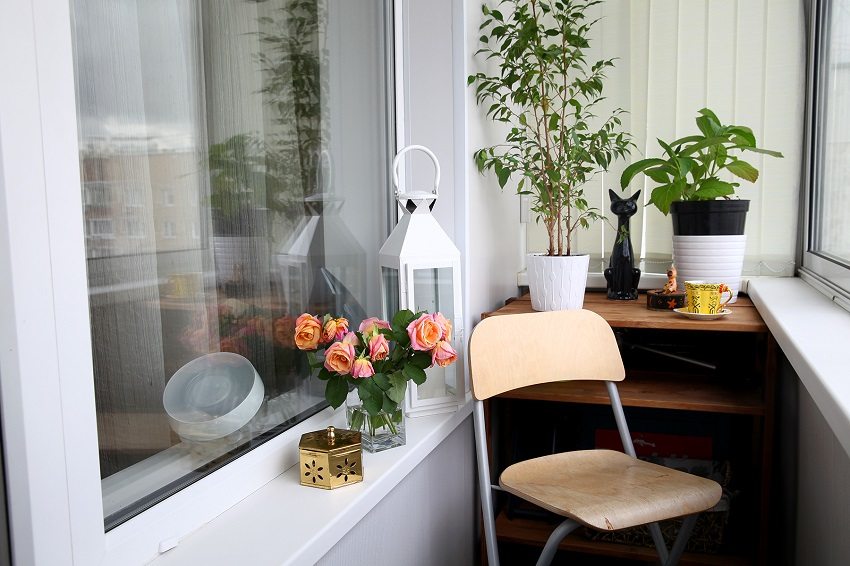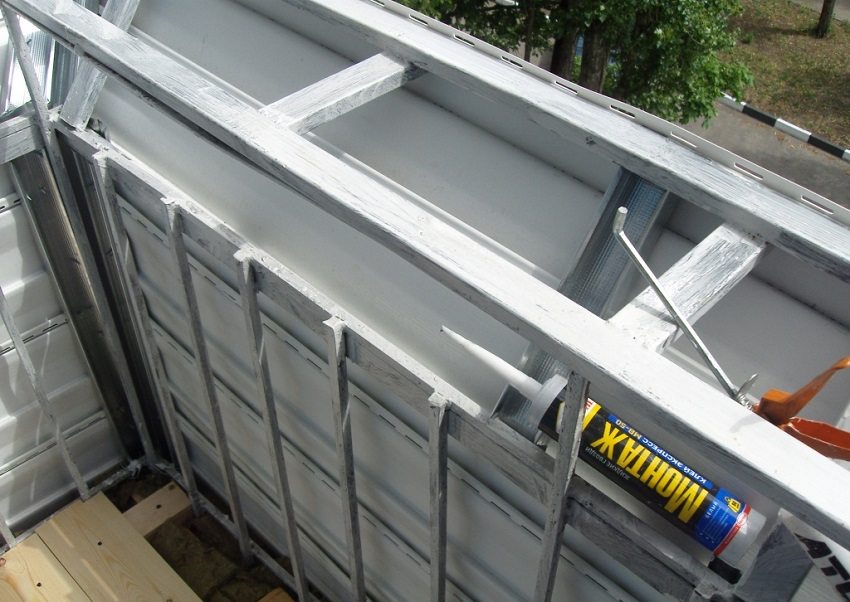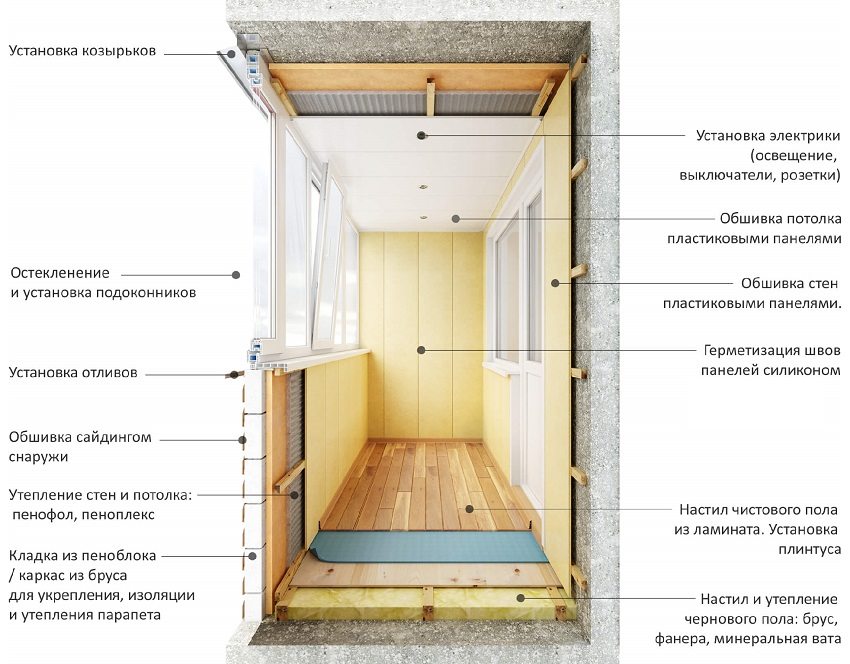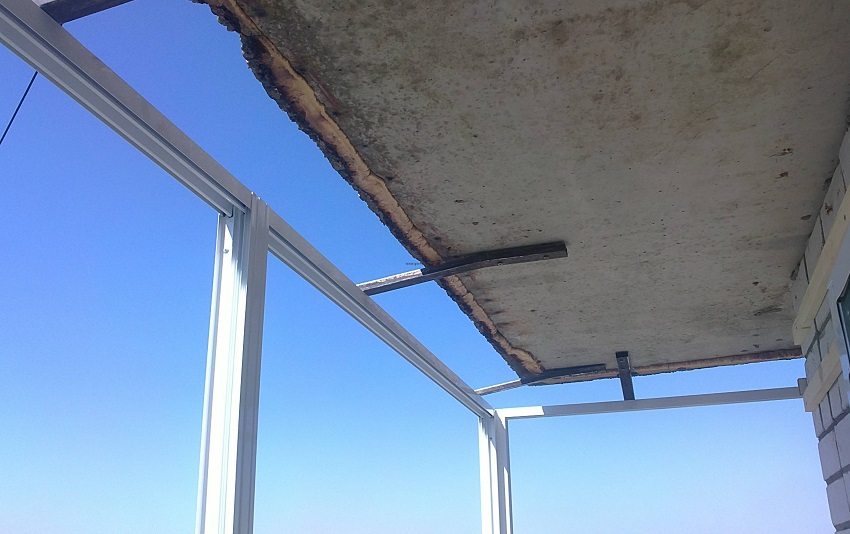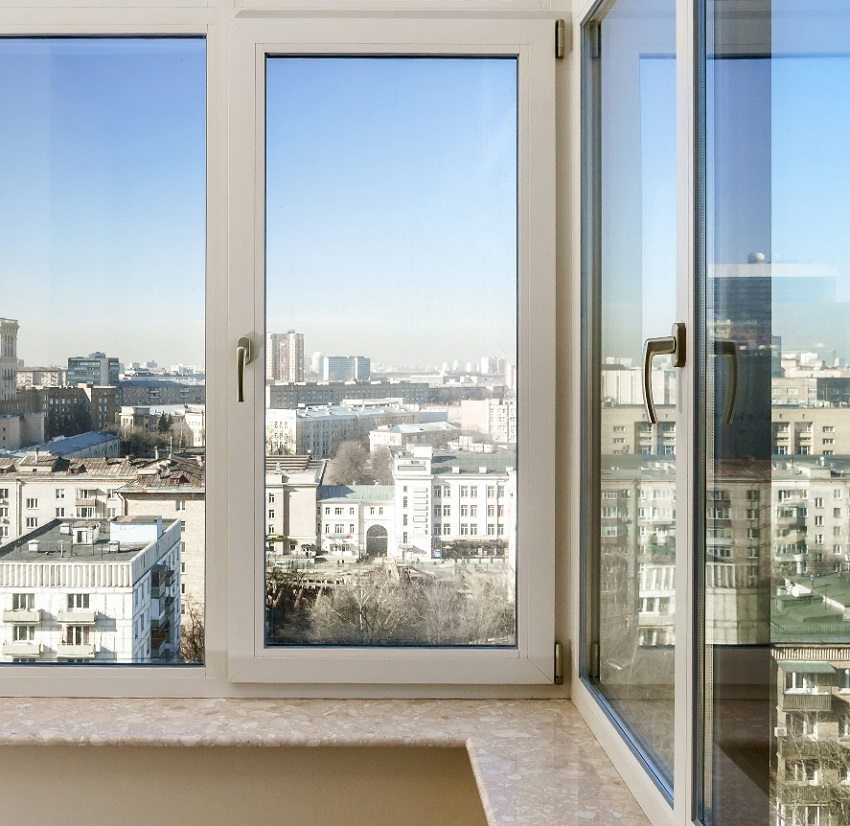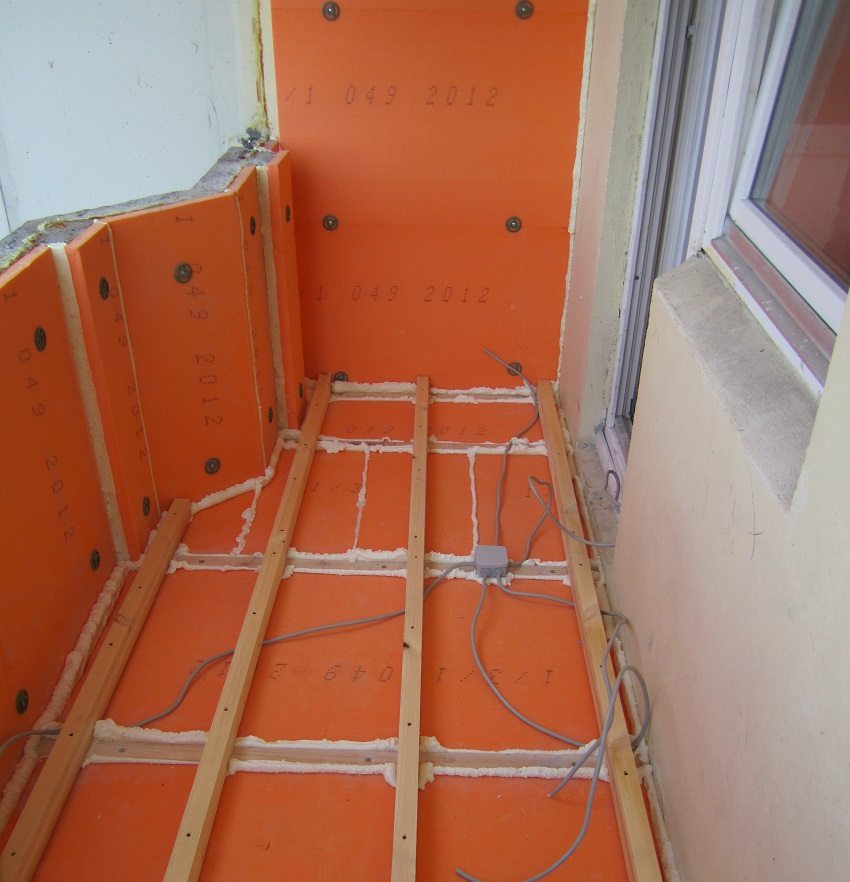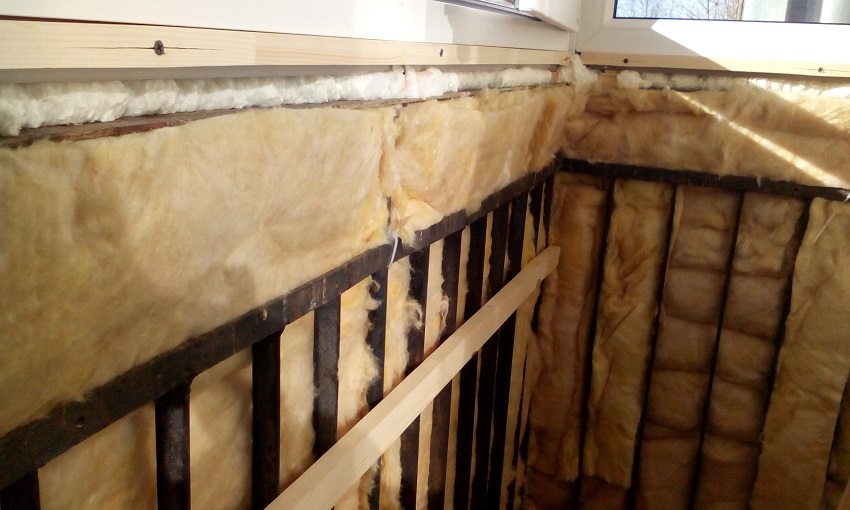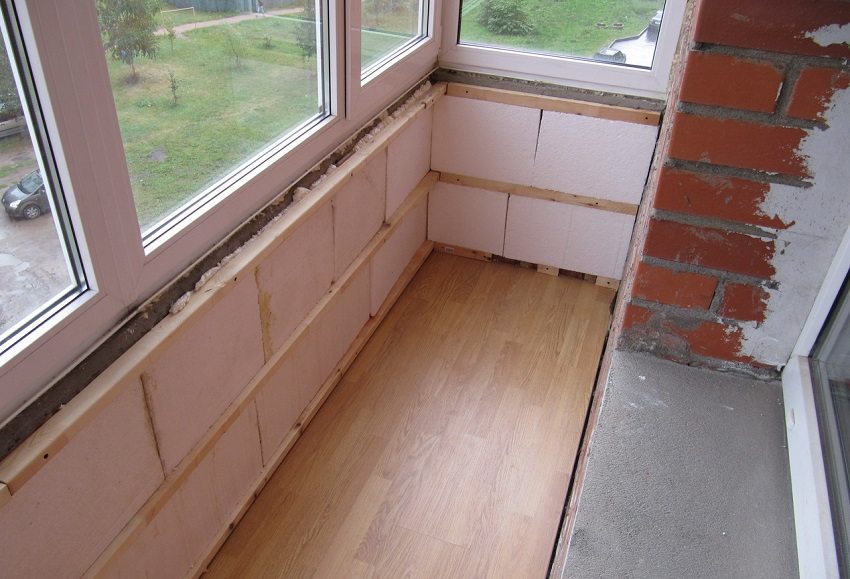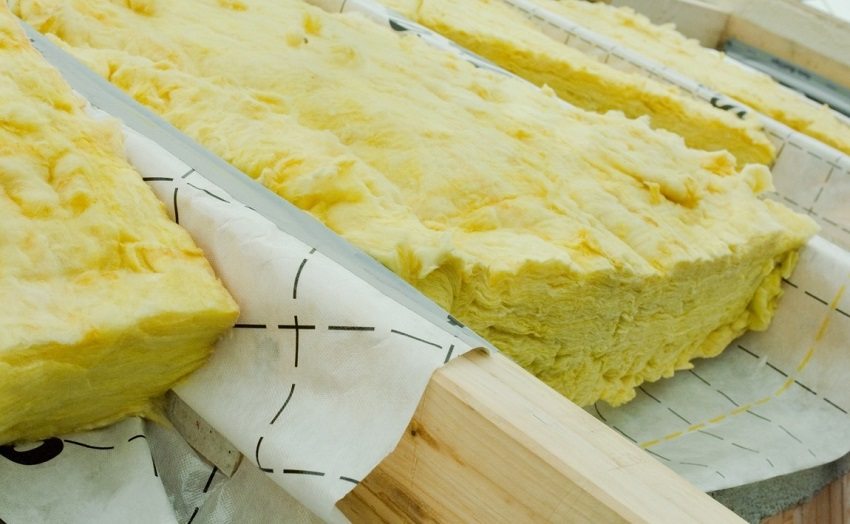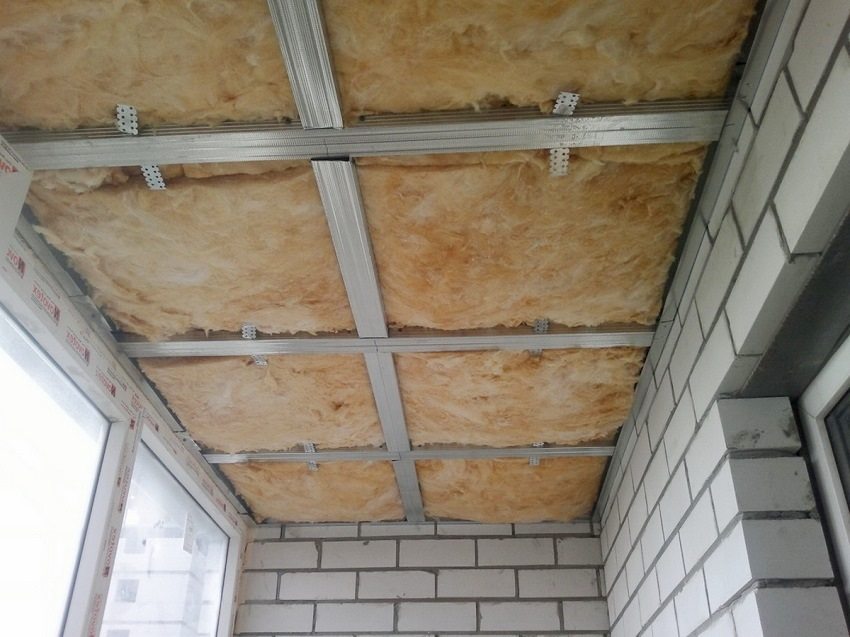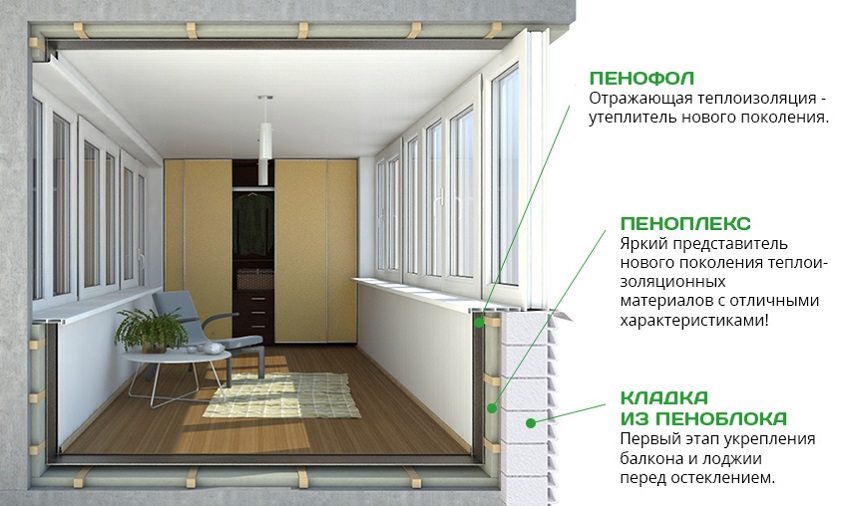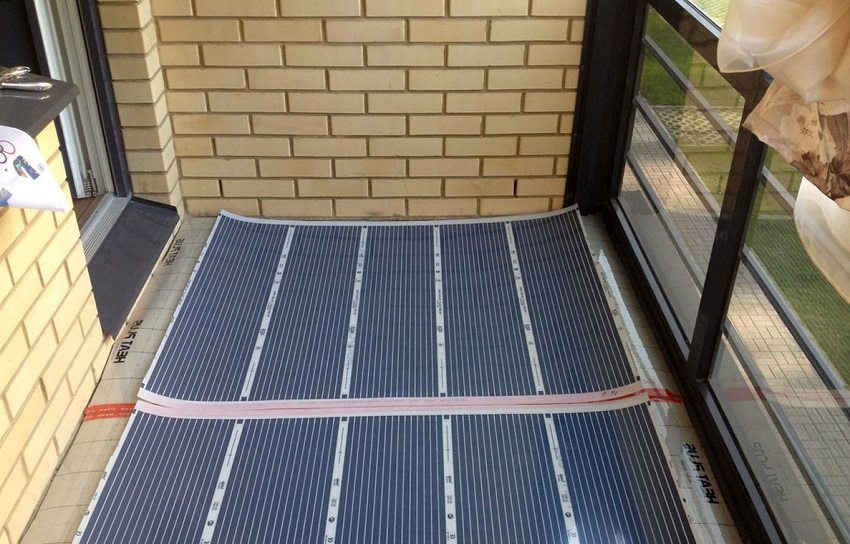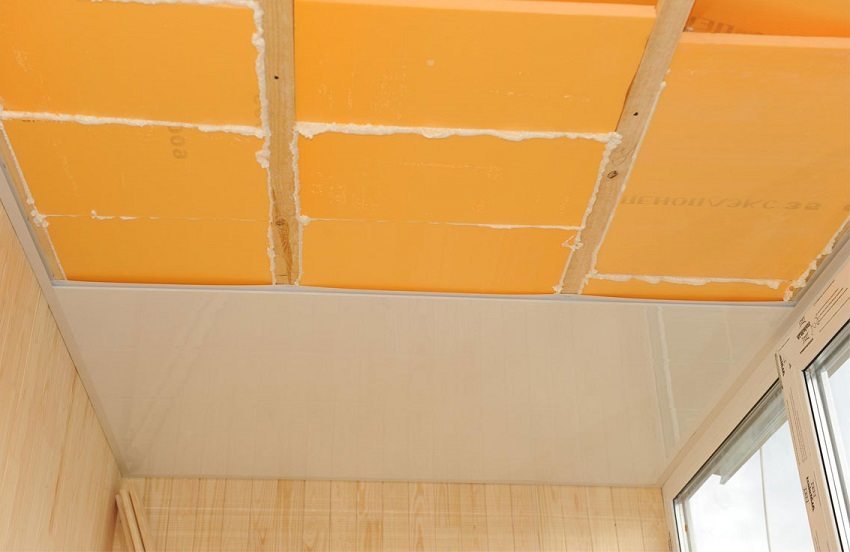A balcony is a place in an apartment that can be used for various purposes. Someone stores various things there, someone uses it to dry clothes, and someone makes a favorite resting place or even a small room from the balcony. In any case, the insulation of the balcony is a very important point that should be paid close attention. If you want to know how to insulate a balcony with your own hands: step-by-step photos and detailed instructions can be easily found on the Internet. The main thing is to avoid common mistakes and strictly adhere to the correct sequence of actions.
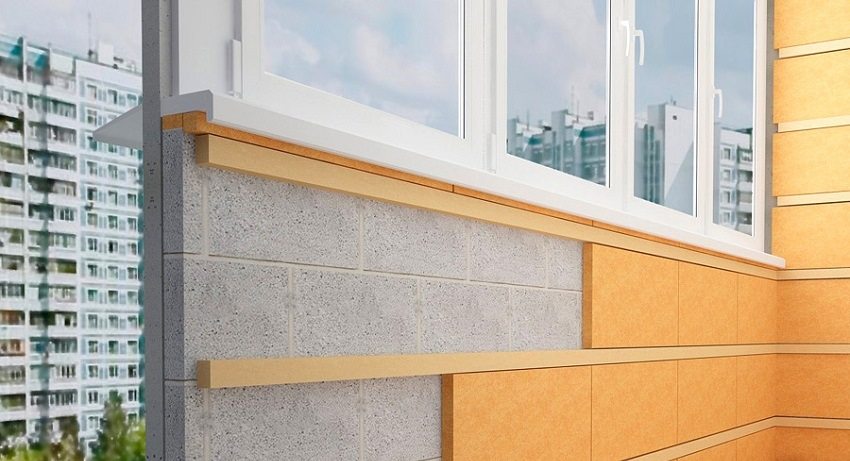
When starting to insulate a balcony, it is important to choose the optimal materials and strictly adhere to the technology
Content [Hide]
- 1 The most common mistakes when insulating a balcony
- 2 Installation of double-glazed windows
- 3 How to insulate a balcony with your own hands: step by step photos
- 4 The better to insulate the balcony inside, the nuances of insulation in different seasons
- 5 Do-it-yourself balcony interior decoration: step-by-step instructions and recommendations
The most common mistakes when insulating a balcony
There are several points in which many are mistaken when insulating a balcony on their own:
- Rush. Often the insulation of the balcony takes place in haste. Usually, this means covering the cracks with putty, installing warm windows and plugging in the radiator. At the same time, the heat from the apartment continues to leave through the balcony, which is very surprised by its owner.
- The use of substandard materials. Therefore, how to insulate the balcony inside is an important question that must be asked before starting work. A balcony is a fairly large space, so poor windows or improperly laid floors can create serious warm air leaks.
In order to balcony and the whole apartment was protected from the cold as much as possible, a certain procedure should be followed. So you will save time, effort and get high quality insulation. If you want to know how to insulate a balcony with your own hands - step by step photos will help you with this.
Installation of double-glazed windows
The first stage, from which the insulation of any room begins, is the installation of modern double-glazed windows. If you have old wooden frames, then a very large amount of heat escapes through them, no matter how warm you are. But when installing double-glazed windows on a balcony, there is one nuance that distinguishes it from other rooms - a parapet. On many older balconies, it is not strong enough to support the weight of heavy PVC windows. In this case, it will have to be further strengthened.
Helpful advice! It is best to strengthen the parapet with reinforcement.Thick iron bars and cement will carry any additional weight well. The brick option is also fine, but thicker and heavier.
Before you insulate the balcony with your own hands, you need to decide on the material of the window structures - it can be PVC, aluminum or wood frames.
Properties of different types of windows
Wooden frames are the cheapest, but not the best option in terms of window properties. Wooden frames do not retain heat well and are not airtight. It is worth using them only if there are no severe cold weather in your latitudes.
Aluminum windows are more expensive, but retain heat better. In addition, they are the most reliable and durable, they perfectly resist corrosion and other negative influences.
PVC frames are the best option in terms of price and quality ratio. Polyvinyl chloride is not afraid of dampness and temperature extremes. It is not as resistant to stress as aluminum, but it provides the highest level of thermal conductivity.
How to insulate a balcony to keep it warm in winter? The following types of windows are well suited for this purpose:
- with hinged doors;
- with double-glazed windows;
- with advanced profiles.
How to insulate a balcony with your own hands: step by step photos
When insulating a balcony, one of the most important points is the thickness of the insulating layer. It often turns out that it is necessary to insulate not only the walls, but also the floor and ceiling. The main criterion for a material for insulation is its thermal conductivity. This figure is inversely proportional to the amount of heat that the material can hold. One of the most frequently asked questions during insulation is what is the best way to insulate a balcony: with foam or mineral wool? It all depends on your financial capabilities.

Penophenol - a new generation thermal insulation material, perfect for insulating balconies from the inside
The most common material for warming balconies is extruded polystyrene foam. It is thin, lightweight, easy to cut and install, durable and highly resistant to moisture and corrosion. Its only drawback is the rather high cost. In this case, foam is a budget option for insulation for the balcony. It is also lightweight and easy to install, but less durable.
Sealing cracks
There are cracks in any old balcony - this is an axiom. Heat will escape through numerous slots even if you have installed the warmest and most modern double-glazed windows. It is best to seal them up with polyurethane sealants and mastics, which are quite plastic, hold for a long time and are resistant to all sorts of natural influences, such as frost or wind.
The slots are closed using a special gun or a plastic nozzle that comes with the cylinder. After the mastic or sealant has completely dried, you can proceed to the installation of the insulation. If you do not know how to insulate a balcony with your own hands, a step-by-step photo will help you in this moment.
How to insulate the floor and walls on the balcony with your own hands
After choosing and buying a heater, it must be fixed. Usually, this is done with dowels or construction glue. When installing with glue, you need to choose a composition without toluene - it can corrode the material. If you decide to attach the insulation with dowels, then they need to be placed around the perimeter with the calculation of about 10 dowels per square meter.
Use step-by-step instructions, photos and videos, which can be found on specialized resources, when insulating a balcony with your own hands.
Balcony wall insulation stages:
- installation of a vapor barrier film with gluing joints with construction tape;
- installation of battens made of wooden bars or metal profiles;
- installation of insulation - foam, mineral wool, etc .;
- sheathing of the lathing with moisture-resistant plasterboard, plywood or other sheet materials;
- finishing the walls.
Helpful advice! Seams between layers of insulation or foam plates must be sealed with polyurethane foam. This will prevent heat loss through them.
Each type of surface has its own nuances of insulation. So, before insulation, the floor should be leveled and waterproofed on it. And the use of vapor barrier tape will insure you against such troubles as mold and mildew. Walls and ceiling can be sheathed with moisture resistant plasterboard. Photos of the design of the insulated balcony show that drywall, with proper finishing, looks great here.
Stages of insulation of the balcony floor:
- installation of a waterproofing film with treatment of joints with moisture-resistant mastic or sealant;
- laying a heat insulator - for example, foam;
- pouring a concrete screed with a thickness of 4-5 cm (an electric underfloor heating can additionally be installed in the screed);
- finishing of flooring - laminate, linoleum, ceramic tiles.
It is possible to equip and insulate the floor on the balcony without using a concrete screed. For this, after the arrangement of waterproofing, wooden logs are laid in the longitudinal direction of the balcony, which are attached to the concrete base. Between the logs, a heat-insulating material is laid - penoplex, basalt wool, expanded clay, etc. Boards or sheet material (plywood, chipboard, etc.) are attached to the logs and the finishing flooring is equipped.
Balcony roof insulation
If the roof of your balcony is not a neighbor's floor, then a separate approach is needed to insulate it. The video "How to insulate a balcony from the inside with your own hands" clearly demonstrates the whole process. It is necessary to choose a reliable roofing material; it is advisable to apply sound insulation in the form of spraying or film on its inner side. The following layers are also used:
- waterproofing - films made of polyvinyl chloride or polyester are perfect here;
- windproof membrane - allows steam from the insulation to pass through, but does not allow drops that can penetrate with the wind;
- anti-condensation layer - prevents water vapor from flowing onto the insulation;
- wooden frame - holds the roof;
- the insulation itself - serves to insulate the roof;
- insulation vapor barrier - retains the insulating properties of the insulation, does not let water vapor inside it.
Additional insulation
In order to keep warm on your balcony even in the most severe frosts, you can install a radiator on it, air conditioning or even a warm floor. The answer to the question "What is better to insulate balconies from the inside?" depends on your imagination, needs and financial capabilities.
If the balcony is combined with the room, then additional insulation can be omitted, the air conditioner will do a good job with this task. But there is a nuance - the air will warm up, and the floor will still remain cold, even if it is carpeted. Therefore, underfloor heating is a very appropriate option for complete insulation of the balcony. Installation of underfloor heating is another difficult moment that should be entrusted to experienced professionals. Also, a step-by-step video instruction for insulating a balcony with your own hands helps here.
The better to insulate the balcony inside, the nuances of insulation in different seasons
Sometimes it happens that it is necessary to insulate the balcony in winter. Many are interested in whether it is worth doing and what the threat is. It all depends on the materials used for insulation. Some of them change their properties at subzero temperatures, and it becomes more difficult to handle and install them.
It is quite problematic to insulate the balcony with penoplex with your own hands in winter, and cement in the cold freezes very quickly and does not have time to grasp properly. This leads to the weakening of the masonry and the rapid destruction of the parapet. But there are a number of special winter adhesives and mixtures that are focused on use at low temperatures. A video of how to insulate a balcony with your own hands in winter can also be found on the Internet.

After installing the insulation, they proceed to the finishing finishing the balcony
Polyurethane foam also depends on temperature. If you choose the "summer" option for winter insulation, then this will not lead to anything good - the foam will quickly collapse and become unusable.
Related article:
Interesting ideas for finishing balconies, photos and choice of material. Selection of the most suitable material for interior decoration of balconies and loggias with their insulation with various materials and glazing.
Another important point to consider when insulating is dampness. You can often encounter it if you insulate a balcony in autumn or spring. Most types of glue or mastic do not stick to a damp surface, and humidity also has a very bad effect on the operational properties of insulation, if it is not foam. That is why it is necessary to start insulation and waterproofing of the balcony from the ceiling. In this case, sudden rain will not prevent you from continuing to insulate the walls and floor.
Helpful advice! Balcony insulation with penoplex and penofol can be done even in high humidity conditions.
From all of the above, it is clear that it is possible to insulate a balcony not only in summer. The only exception is if the temperature drops below 20 degrees. Then even the most frost-resistant materials begin to behave very badly, and normal insulation will not work, even if you know for sure how to properly insulate the balcony from the inside.
Do-it-yourself balcony interior decoration: step-by-step instructions and recommendations
If the answer to the question "How to insulate a balcony with your own hands?" and step-by-step photos can be easily found on the Internet, then the interior decoration is completely at your discretion. The best option here is drywall, which is moisture resistant and easily lends itself to further finishing: painting, tiling, wallpapering.
The wiring can be hidden in hollow plastic casings to keep it out of sight, and the floor can be carpeted. The step-by-step video "How to insulate a balcony from the inside with your own hands" will help you decide on the type of insulation and the design of the interior decoration.
By the way, one of the most frequently asked questions is "How much does the insulation of the balcony and its finishing cost?" There is no exact answer to it, it all depends on the materials chosen and the complexity of the work.
